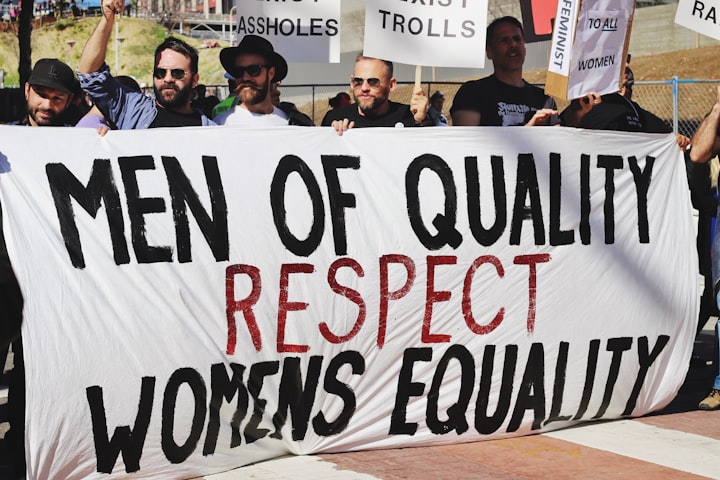Drown Your Wife if She Can't Cook?
Cyber Sexism

The new weapon of violence against women
This essay examines the various sexist practices on the Internet called cyber sexism. The Internet seems to become a new world for patriarchal domination.
The amount of content, comments, and memes circulating on the Internet and social media, such as Instagram, Facebook, Twitter, and WhatsApp harassing women, is proof of the patriarchal power on the Internet.
I used a qualitative method with a feminist perspective, collecting memes through Instagram, Facebook, Twitter, and WhatsApp. The memes were then reviewed and interpreted to find their meaning. Using Pierre Bourdieu's habitus theory and symbolic violence. Memes were analyzed to find the factors that cause sexism against women. The logical link between sexist practices in the real world and cyber sexism on the Internet.
Results indicate that people's habitus about patriarchy has become a mental structure of society that influences stereotyped behavior and gender bias and plays an important role in sexism on the Internet. The Internet, as an arena, has become the initial capital for men to dominate. Naming and mentioning women in various memes are the forms of symbolic violence against them that form new sexist habitus on the Internet.
The Internet knows no boundaries of space and time.
This sentence first emerged from Tim Berners-Lee, an inventor of the World Wide Web. The Internet must be a neutral place not insulated by social, cultural, gender, economic, and political structures. Anyone and anywhere has the right to use it to build new interactions or expand knowledge. Although the Internet knows no boundaries of space and time, it still provides 'boundaries' to its users.
Anyone who wants to join social media such as Facebook, Twitter, or Instagram. Must register themselves by submitting several identities. including their gender identity.
The world of the Internet is also an arena for class interaction that dominates and is dominated.
The gap between men and women also occurs on the Internet due to socio-economic and gender backgrounds. Economic stability, skills, and expertise in using computers and gadgets are the capital for men to carry out their legitimacy efforts.
Knowledge and mastery of text and image processing applications are more friendly to men because their creators are still being dominated by men.
I also discovered that the massive language of violence against women on the Twitter application was also caused by male domination of technological knowledge.
The phenomenon of the Internet and the phenomenon of technology cannot be fully understood without reference to gender issues.
The social construction theory of technology shows that technology is socially shaped in specific social contexts.
Gender discourse and stereotypes on the Internet are also identified in social contexts related to the dichotomy, namely public space and private space.
People's perspectives are still influenced by gender role stereotypes, which place women in the domestic sphere and men in the public sphere. By looking at the relationship between feminist theory and information technology. I identified women's exclusion in new technologies' invention, creation, and design. Ultimately, this situation causes the existence of sexist behavior and patriarchal dominance on the Internet.
This condition undoubtedly harms women. Both on the Internet and in the real world. The existence of women will always be considered as the second sex.
Katharine Jarmul is an algorithm consultant in the United States. She revealed that various internet algorithms used today are often gendered, biased, and sexist. They promote female stereotypes.
Algorithms profoundly influence how gender is shaped, processed, and recirculated in contemporary consumer culture. Amid understanding gender equality and justice. Internet algorithms tend to strengthen dualism and the hierarchical position of gender. The Internet has redefined gender stereotypes and unequal understandings.
Gender barriers in cyber-space are erected, in part, by language and code issues.
I found a lack of female voices and actors on the Internet and suggest that male rituals and linguistic patterns dominate. Algorithms influence how gender is experienced. Processed, and recirculated in contemporary consumer culture.
While consumers and researchers embrace a broadening conception of gender. The online marketplace seems to be working to reinscribe stereotypical notions of gender.
Sexist Memes
The domination and gender inequality experienced by women in the cyber world is strong proof of the domination of patriarchy. Sex, however, places more importance on status as the pivotal determinant of society's position. Being the dominant social group, men engage in behavior that creates hierarchical social structure domination of the patriarchal system. Therefore, social power is reflected in men as a function of their ruling masculine status. Various sexist practices against women are often easy to find on the Internet in various forms: including memes.
Memes were first used by Richard Dawkins (2006) an ethologist, and evolutionary biologist. In his book The Selfish Gene. He defines memes as the ability to reproduce, process, and disseminate the information structure of genes in biology. Memes are replicators that can influence human evolution through variations and distinctions that affect human life habits.
In its development, the term meme is not only used in the field of biology. Memes are now more widely used as a term in human culture as carriers of traits, patterns, and ideas of a culture that ultimately change the habits of a generation. In addition, memes can also be associated with infectious ideas or thoughts, ideas that spread by themselves, and cultural aspects that tend to be imitative, both ideas, behaviors, and physical objects.
As a cultural product, memes are a form of representation of the behavior of a social group. In addition, memes show the existence of a communication process both between group members (individuals) and between these social groups.
The relationship between creators, readers, and the meme itself is complex as a form of visual communication. Memes that are generally in the form of text and images contain symbols that must be interpreted in the context of communication. Therefore, the reader's background knowledge is vital in understanding a meme's intent, purpose, and meaning.
A meme in the internet world is defined as the rapid spread of a particular idea or idea presented in the form of text or images groups of words, pictures, or a combination of both that repeatedly appear as messages.
Internet memes are related to ideas, perceptions, emotions, behaviors, and even everything that can create instant experiences. I define internet memes as digital devices that share a common character (form, content, attitude) consciously created, circulated, imitated, or transformed by many internet users. Likewise, memes as a means of communication in the form of symbols that can be text or images to convey messages or ideas.
Unfortunately, the messages that appear in memes are often sexist and stereotype women.
Various memes in text and images with the content of harassment against women can be easily found on the Internet. The domination of patriarchy does occur in not only the real world but also the world of the Internet. This dominance effect ultimately leads us - consciously or not - to become accustomed to these harassing memes. In fact, not a few internet users share and spread it in their acts of communication, as humor - sexist humor.

If we look at the contents of the meme above the text reads, "Have a wife, cannot cook? Drown her!".
In this case, women are considered domestic beings who must carry out domestic activities, such as cooking, washing, cleaning the house. This also shows the strong ideology that men have a higher position than women, and women are always subordinated to men. Whether we realize it or not, the use of these sentences and images has given birth to cyber sexism and the domestication of women.
Cyber sexism is also a vehicle for transmitting social norms inviting stereotypical performances of femininity and masculinity.
Conclusion
Although the world has changed for the better and human civilization is progressing with the Internet, the fate of women seems to have stepped in the opposite direction, even worse. The phenomenon of cyber sexism on the Internet is proof of how the fate of women is determined.
The emergence of the Internet does not change anything about the condition of women. Stereotypes, domination, and subordination remain intact attached to the female body. The world, for women, has not changed with the advent of the Internet.
The domination of patriarchy still occupies the top of the mental structure of most people. Patriarchy is a habitus that is not easily lost or even forgotten. Its presence will continue to be reproduced in line with the development and progress of the times.
The many sexist memes are proof of the legitimacy of the patriarchal culture that positions women as objects. This behavior takes advantage of the socio-cultural mental structure that surrounds the lives of society. The concepts of sexism and gender become a means of strengthening male domination. Due to the development of a socio-cultural mental structure as Habitus in a very long time, women as victims do not realize and accept these forms of symbolic violence as normal.
Patriarchy has become a habitus in many different forms and places, real and virtual. The Internet has become a new world for the domination of patriarchy, perpetuating men's power over women. In the end, cyber sexism can be understood as a new way to control the dominance of certain genders virtually.
About the Creator
Arlo Hennings
Author 2 non-fiction books, music publisher, expat, father, cultural ambassador, PhD, MFA (Creative Writing), B.A.






Comments
There are no comments for this story
Be the first to respond and start the conversation.